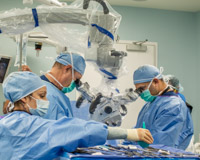Vertebrae (bones of the spine) are separated by intervertebral discs. These cartilaginous discs help to distribute weight, absorb shock, and keep vertebrae oriented in the correct spacing. Degenerative disc disease refers to the breakdown of these intervertebral discs. Natural degeneration of discs occurs over time. Trauma or repeated abuse may cause a more sudden degeneration. Discs in the lumbar and cervical area of the spine are most frequently affected. Degenerative disc disease can cause painful symptoms in the lower back, neck, legs, and arms.
Intervertebral discs are composed of two primary components: a soft inner nucleus pulposa, and a tough exterior fibrous cartilage called the annulus. The nucleus provides the main shock absorbing capacity, while the annulus forms a solid framework for the nucleus. It may help to visualize a thick rubber waterbed full of viscous fluid. The fluid component corresponds to the nucleus, while the rubber casing represents the annulus.
As a person ages, intervertebral discs naturally dehydrate. This dehydration leaves the annulus susceptible to tearing. Micro-tears in the annulus will scar over, leaving a weaker support structure around the nucleus. Tearing is often accompanied by pain, and local inflammation. Furthermore, the weaker support structure can cause minor instabilities in the spine. These instabilities result in a disc that is more susceptible to injury.
As the annulus dehydrates, the intervertebral disc becomes thinner. As vertical height of the disc changes, so does the relationship between the vertebrae above and below the disc. Vertebrae form joints with the adjacent vertebrae, called facet joints. These joints are particularly affected by any changes in intervertebral disc height. Rubbing may occur at the facet joints, creating reactive bone spurs. Similar to forming calluses on your hands, constant rubbing of an area will cause the body to attempt to protect the area. These bone spurs can push into the area normally occupied by spinal nerve roots, or the spinal cord, causing discomfort.
If the annulus is significantly compromised, a disc herniation may occur, in which the nucleus pushes through the outer annular ring. This causes concentrated pressure on a nerve area.
Signs of potential degenerative disc disease:
Discomfort in the lower back or neck may be related to annular tears and early stages of degenerative disc disease. Pain is typically worsened by certain activities, such as prolonged sitting or twisting motions. Pain is often relieved by other activities, such as lying down, or walking. Alternatively, pain may be felt radiating in the legs or arms, with accompanying tingling and numbness. If weakness of the arms or legs is observed, consult your physician immediately.
How will I know definitively?
If experiencing frequent pain in the lower back or neck, you may wish to consult a physician about the possibility of degenerative disc disease. A physical examination, as well as X-rays or MRI will be able to show definitively if the intervertebral discs are the cause of pain. DISC offers in house imaging and on site clinic so patients can receive a fast and accurate diagnosis without having to visit multiple offices. Click Here to view board certified spine specialists.
What can I do about Degenerative DISC Disease?
There a number of surgical and nonsurgical approaches to treat degenerative disc disease. Fortunately, the term “degenerative” does not mean a steady decline in fitness when discussing degenerative disc disease. The majority of patients are able to find relief through non-surgical measures. Physicians at DISC offer a broad spectrum of soft tissue, targeted strengthening, traditional eastern, pain management and microsurgical techniques to treat degenerative disc disease.
Nonsurgical Degenerative Disc Treatment
In many cases, 6 weeks to two months of physical therapy can remedy pain caused by degenerative disc disease. Targeted exercise such as Med-X to increase core strength and stability will often benefit patients suffering from degenerative disc disease. Stretching exercises and traction are frequently helpful in treating symptoms. In some cases, the use of a back brace can aid in pain control during the initial stages of physical therapy.
In more problematic cases, administering corticosteroids to the affected area can provide temporary relief. DISC Pain management specialists perform these minimal procedures in the ultra-clean and modern DISC surgery center. Muscle spasm and inflammation may be managed through icing and stimulation treatments. These measures allow the continuation of physical therapy with minimal resulting discomfort.
97% of patients find relief through physical therapy and/or a combination of physical therapy and pain management procedures. (learn more about the Soft Tissue Center conservative services)
Surgical Options
If non-surgical measures do not provide suitable relief, a variety of surgical procedures are available to treat degenerative disc disease and resulting complications. Surgery options treat the root of the problem, tailored to each unique situation. DISC surgeons utilize advanced minimally invasive and microsurgical techniques to alleviate the condition with the minimal disruption possible. Patients undergoing surgery at DISC typically return home the same day of surgery and experience an accelerated recovery.
A damaged disc may protrude, putting pressure on spinal nerve roots or the spinal cord. A minimally invasive procedure called a microdiscectomy can be performed to remove the area of damaged disc, relieving direct pressure on nerves. To gain access to the intervertebral disc, the lamina (bony surface that protects the intervertebral disc) must be partially removed. A laminotomy or laminectomy is performed to allow access to the disc. Laminectomies are performed on an outpatient basis at the DISC surgery center, using minimally invasive techniques to preserve as much natural bone and tissue as possible.
To maintain the proper orientation between vertebrae, a fusion operation may be necessary. This forms a bony bridge between two vertebrae, locking their position relative to one another. Depending upon the site of injury, there are many minimally invasive options for vertebral fusion. ACDF, or anterior cervical discectomy and fusion, is a multi-component surgery that removes damaged disc in the neck, as well as fuses the affected vertebrae. An XLIF, or eXtreme Lateral Interbody Fusion, fuses vertebrae in the lumbar region (lower back) without large incisions or long recovery times. Multiple vertebrae may be fused simultaneously in a combined fusion procedure. Even fusions, which are traditionally associated with lengthy hospital stays are routinely performed on an outpatient basis at DISC, allowing patients to recover safely and comfortably in their own homes.
Bony spurs on facet joints that result from degenerative disc disease can be removed by a facetectomy. This removes unnecessary bony build-up.
Degenerative disc disease is a common occurrence and is often managed through non-surgical therapies. Frequently, dull pain in the lower back or neck signifies early stages of degenerative disc disease. If pain is felt radiating down the arms or legs, especially if accompanied by numbness and weakness, a medical professional should be consulted. Keep in mind, “degenerative” does not mean a decline in fitness over time. Proper management may completely alleviate and halt the progression of further painful symptoms. You do not have to live in pain. DISC physicians are available to diagnose and treat degenerative conditions of the neck and spine. (Click here to view physicians)
For more information about Degenerative Disc Disease visit American Academy of Orthopedic Surgeons-AAOS

About the author
discmdgroup DISC Sports & Spine Center (DISC) is a national leader in minimally invasive spine surgery, orthopedic surgery, and sports medicine care. Our spine surgeons set the standard in artificial disc replacement, spine fusion, discectomy, microdiscectomy and the full spectrum of spine procedures. The group’s orthopedic surgeons advance the state of joint preservation surgery and total joint replacement, including total knee replacement as well as total hip replacement. Our flagship surgery centers based in Newport Beach, Marina del Rey, and Carlsbad serve patients local to Los Angeles, Orange County and San Diego, as well as the rest of the country. Read more articles by discmdgroup.





